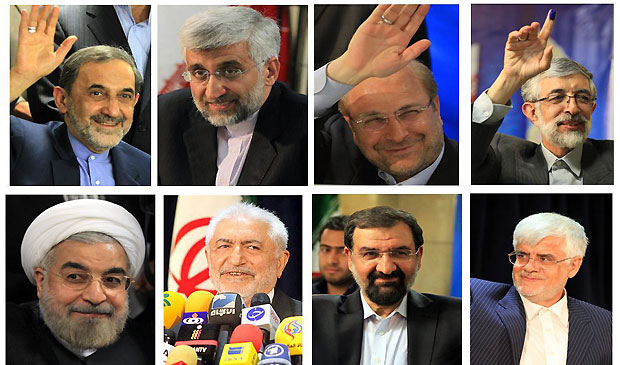In Tehran, they call them the eight dwarves. The sobriquet may be unfair. Though unknown to many Iranians, the eight men standing for election as president of the Islamic Republic are prominent figures in the narrow elite that have dominated Iran’s politics for three decades. Who are these men? And would it make any difference which one enters the presidential palace on Pasteur Avenue next month?
Cut from the same cloth, the eight have much in common.
They are all men, even though women account for a majority of the population. The average age of the eight is 25 years above the average for the Iranian population.
They are all government employees, most of them from the start of their careers.
All but two have been members of the Islamic Revolutionary Guards Corps (IRGC) at different times. Two of the candidates are retired IRGC generals. Three are related to one another and, through marriage, to the supreme leader, Ali Khamenei. Four others are related to various mullahs through blood links or marriage.
All but two of the eight come from middle-class backgrounds, which enabled them to obtain higher educations, including in the West during the era of the Shah.
All but one boast of being PhD recipients and “doctors” of something or other. Even the single mullah among the candidates likes to be described as Aghay Doctor rather than use a religious title such as Hojjat Al-Islam or Ayatollah. The military men among the candidates also prefer the title “Doctor” to that of “General.” The reason is that in the eyes of many Iranians, religious and military titles have been somewhat discredited. Three candidates make a meal of the fact that they did part of their higher education in the United States or Britain.
Though employed by the government, all eight are also engaged in business activities on the side. These range from ownership of hotels and construction firms to news websites.
Two of the eight are subject to international arrest warrants for involvement in the assassination of Iranian political exiles in Berlin and Paris. If elected, they might find it hard to travel abroad.
Needless to say, all eight hail from the same ideological niche. This is a hodgepodge of old-style leftist clichés, Third-worldist complexes, and messianic misunderstandings; this dish is then served with a pseudo-religious sauce. The father of this peculiar ideology, Ruhallah Khomeini, was a rabble-rouser with little understanding of the complexities of Islamic theology and philosophy. A man of limited vocabulary who never managed to master either Persian or Arabic, he had a genius for oversimplification. This helped him develop a Manichaean discourse that continues to appeal to those who seek simple answers to difficult questions.
Nevertheless, the eight do represent different trends within the same ideological niche. Saeed Jalili, the youngest candidates and the man generally regarded as Khamenei’s favorite—although I do not personally ascribe to this view—appears to be the most earnest when he professes “pure Khomeinism.” That, however, may be due to a lack of political experience, if not outright naiveté. The most sophisticated version is offered by Mohammad Reza Aref, who pretends that Khomeinism could be reinterpreted as an Islamic version of Christian Democracy.
A man of the seraglio, Ali-Akbar Velayati has steered clear of ideological entanglement. Instead, he is trying to cast himself as a safe pair of hands to negotiate Iran’s way out of the foreign policy impasse it has created for itself. Lacking in charisma, he would be an ideal factotum for Khamenei.
None of the eight have offered any economic program, although all claim that fixing the broken economy as a top priority.
There may be two reasons for the lack of an economic program. First, no one believes the data published by President Mahmoud Ahmadinejad’s administration, and, second, no one dares offer reforms without a green light from the supreme leader.
All eight insist that there will be no change in Iran’s nuclear policy. That is neither here nor there, because it is the supreme leader, not the president, who has the final say.
None of the eight have demonstrated oratory skills. The most boring orator among them is Jalili, whose long-winded speeches could only be recommended for its soporific virtues. The average mullah is known for masterful oratory—but Rouhani, the only mullah among the eight, is, perhaps, the worst orator of the lot after Jalili. The reason may be Rouhani’s attempts at imitating political speeches he heard during his stint in England and Scotland. The result is a crisis of identity, with a mullah trying to sound like Mrs. Thatcher. For his part, Muhammad-Baqer Qalibaf is an effective speaker in small circles, but becomes hopeless as soon as he faces a larger public. Muhammad-Gharazi, a former IRGC apparatchik, is the only candidate who injects a dose of humor in his speeches and television appearances. This may be due to the fact that he is the only one of the eight to have been away from the centers of power for almost 20 years, hovering on the margins of the establishment. Gholam-Ali Haddad Adel is the only “philosopher” among the eight, but he has still proved totally incapable of developing a coherent discourse.
The only surprise so far has come from Mohsen Rezai, who has become a fixture of Iranian presidential contests after having stood on three previous occasions, when his presence went largely unnoticed. Rezai was made a general aged 27 and appointed Commander of the IRGC during the Iran–Iraq War. He has caused some surprise this time by raising the issue of Iran’s ethnic and religious minorities and highlighting his humble social backgrounds. However, he is unlikely to do any better this time, if only because Khamenei has always been wary of figures with a military background.
The only interest in this election relates to the voter turnout and the performance of candidates believed to be closest to the leader, who is no Snow White.
